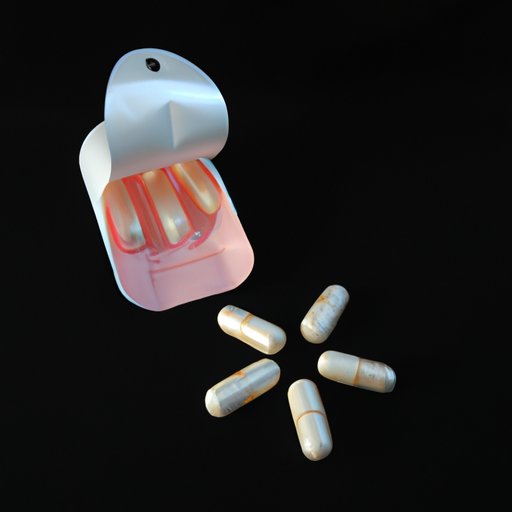
I. Introduction
Vaginitis is an extremely common disorder of the female reproductive system. Characterized by inflammation of the vagina, this condition can arise due to various reasons, including bacterial or fungal infections, hormonal disturbances, or even certain medical conditions. Vaginitis can be annoying, painful, and can have a huge impact on a woman’s quality of life. Therefore, having proper knowledge about its causes and the available treatment options is crucial. This article aims to provide a comprehensive guide to understanding vaginitis, covering everything from its causes and symptoms to natural remedies and medications for treatment.
II. 5 Natural Remedies for Treating Vaginitis at Home
Many natural remedies can help treat vaginitis at home, without the need for medical intervention. Probiotics are good bacteria that can help restore the natural balance of bacteria in the vagina. Consuming probiotics through food such as yogurt or through supplements can help alleviate symptoms.
Tea tree oil, known for its antifungal and antibacterial properties, is an effective remedy for vaginal yeast infections. Diluted tea tree oil can be applied to the affected area or added to bath water to help reduce inflammation and itching.
Boric acid is another natural remedy that has been scientifically proven to be effective against yeast and bacterial infections. Boric acid suppositories can be inserted into the vagina to help treat vaginitis.
Other natural remedies include garlic, which exhibits potent antifungal properties, and coconut oil, which has anti-inflammatory and antifungal effects and can be directly applied to the affected area.
III. The Do’s and Don’ts of Vaginitis Treatment
When it comes to treating vaginitis, there are some common mistakes that people make. Douching, using scented products, or cleansing too frequently can disrupt the natural acidity of the vagina and promote bacterial growth, leading to the development of vaginitis. Therefore, it is recommended to avoid such practices.
Hygiene practices, such as wiping from front to back after using the toilet, wearing loose cotton clothing, and avoiding tight-fitting undergarments, can help prevent vaginitis. Additionally, avoiding long-term use of antibiotics and maintaining safe sex practices can also reduce the risk of developing this condition.
In case of symptoms such as vaginal discharge, itching, or pain, it is important to seek professional medical advice. Treatment options should be taken only under an expert’s guidance to avoid complication or worsening of the condition.
IV. A Guide to Over-the-Counter Medications for Vaginitis
Over-the-counter medications such as antifungal creams or suppositories, or antibiotic creams or tablets, can help treat bacterial or fungal infections that cause vaginitis. Antifungal medications, such as miconazole or clotrimazole, can effectively treat yeast infections. Antibiotics like metronidazole or clindamycin can treat bacterial vaginosis.
It is important to note that different medications have different uses and side effects. Therefore, it is best to consult a doctor before starting over-the-counter treatment for vaginitis.
V. Understanding the Causes of Vaginitis: Effective Treatment Options
Vaginitis can have different causes, including yeast infections or bacterial vaginosis. Yeast infections occur due to an overgrowth of the fungus Candida, while bacterial vaginosis is caused by an imbalances of bacteria.
Treating vaginitis effectively requires an accurate diagnosis of the underlying cause. When it comes to yeast infections, antifungal medications are generally prescribed. Bacterial vaginosis is treated with antibacterial medications such as clindamycin or metronidazole. In some cases, a combination of medications might be used to treat vaginitis effectively.
VI. Yeast Infections vs. Bacterial Vaginosis: How to Tell the Difference and Treat Accordingly
Yeast infections and bacterial vaginosis can have similar symptoms, including itching, burning, and abnormal discharge. However, there are some differences that can help determine the underlying cause. Yeast infections usually produce a thick, white, and clumpy discharge, while bacterial vaginosis will result in thin, grayish-white discharge with a fishy odor.
Both yeast infections and bacterial vaginosis have effective treatments. Accurate diagnosis, followed by treatment with antibiotics or antifungal medications, is usually the recommended course of action.
VII. Preventing Vaginitis: Tips for Reducing Your Risk and Promoting Vaginal Health
Prevention of vaginitis can be achieved through effective hygiene practices, including avoiding the use of scented products, maintaining personal cleanliness, and wearing breathable clothing. Additionally, maintaining a healthy diet, avoiding smoking, and practicing safe sex can help promote vaginal health and prevent vaginitis.
Furthermore, regular visits to a gynecologist to screen for medical conditions and to discuss proper vaginal health and hygiene is essential in the prevention of vaginitis.
VIII. The Benefits and Drawbacks of Antibiotic Treatment for Vaginitis
Antibiotic treatment is often necessary to treat bacterial infections that cause vaginitis. However, overuse of antibiotics can lead to the development of antibiotic-resistant bacteria and can also disrupt the natural balance of bacteria in the vagina.
Therefore, it is essential to use antibiotics cautiously and only when necessary under the guidance of a medical professional. Possible side effects of antibiotics include nausea, diarrhea, and allergic reactions.
IX. Conclusion
Vaginitis is an incredibly common condition that affects women of all ages. The symptoms of vaginitis can have varying degrees of severity, from mild discomfort to severe pain. The most critical aspect of treating and preventing vaginitis is proper hygiene practices coupled with an accurate diagnosis of the underlying cause.
By following the tips and recommendations discussed in this article, it is possible to take control of vaginal health and prevent or treat vaginitis. For those experiencing any symptoms of vaginitis, it is recommended to consult a medical professional as promptly as possible.





